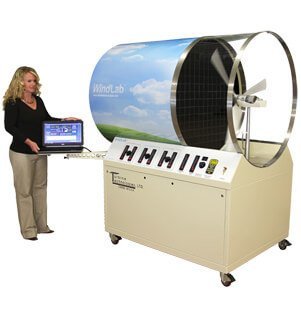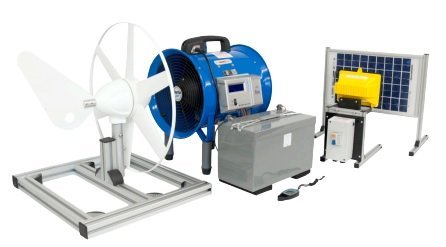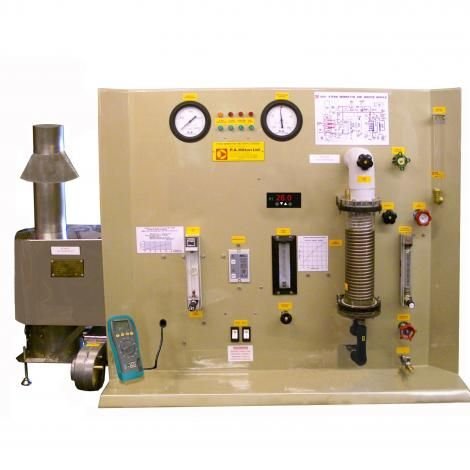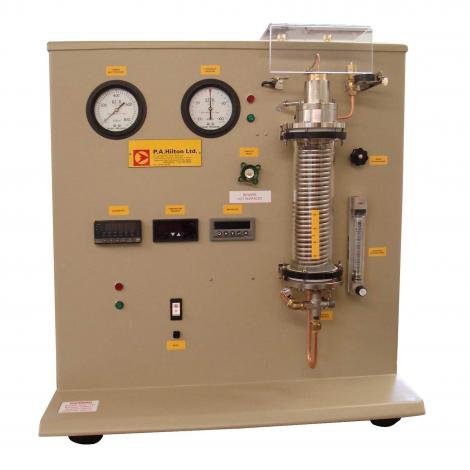Renewable Energy
Wind LAB: WindLab™ is a classroom-sized energy power plant built to last with aerospace grade components including an all alloy planetary gear box, 3-phase power generator, cut-away gondola cover, a stainless steel tower, and rapid prototyped blades.

- Housed in an Air Flow Wind Tunnel
- Programmable Variable Speed Wind Source.
- Performance Comparison Testing
- VI Created Using LabVIEW™
Educational PEM Fuel Cell: Demonstrates a High Watt Density PEM Fuel Cell, generating electrical power directly from hydrogen. Able to be electrically loaded both internally and externally by the operator.

- Brings the class room as close as possible to the contemporary advances in Fuel Cell technology
- Integral Variable Load for Performance Investigation
- Power Output of up to 0.75kW
- Integral Computer Control, Safety System and Computer Interface. Software supplied
Photovoltaic Trainer: A practical sized solar panel with nominal 80W output is connected to a control panel containing relevant instrumentation and a battery charge control system. This in turn connects to a substantial deep cycle sealed lead acid battery. This allows the application of locally sourced loads, or, loads available as optional extras.

- Demonstrates the Practical Application of a Solar Power Generation System
- Expandable 80W Panels and Deep Cycle Batteries, Allow Substantial Loads to be Applied
- Optional Solar Simulator Available
Horizontal Axis Wind Turbine: The Horizontal Axis Wind Turbine allows students to investigate the performance of a typical small scale 3 phase to DC wind generator. The unit will provide interesting and instructive experimental work for all students.

- Variable Blade quantity
- Allows Investigation of an Efficient Three Phase to DC Horizontal Axis Wind Turbine
- Safe and Suitable For Student Operation
- Instrumentation Allows Detailed Analysis of Turbine and Generator Performance
Combined Wind and Solar Generator Demostration: To investigate the detailed performance of both wind and solar components and to investigate the use of DC power for practical applications. Both the solar panel and wind generator connect to a digital combined charge controller that allows the output power from both the solar panel and the wind generator to be investigated.

- Demonstrates the Practical Application of a Solar Power and Wind Powered Generation System
- Allows Investigation Of System Performance Inside The Laboratory Irrespective Of Outside Conditions
Steam
Steam Generator And Service Module: A bench top unit which provides a gas fired steam generator for wet or superheated steam. A condensing unit with air ejector and a closed feed water system allow the Rankine cycle to be investigated.

- Steam Generator: Stainless Steel, continuous coil
- Burner: Ring type gas burner for LPG Or Natural Gas
- Air Extraction: Water jet air ejector
- digital CO2 meter ,pressure gauges ,digital temperature
Steam Turbine Module: Bench top steam turbine module incorporating a single stage impulse steam turbine with water cooled friction brake, condenser, condensate measurement and all instruments and safety devices.

- Friction force measured by load cell
- Digital Tachometer: Range 0 to 99999 rev. min-1
- Digital Brake Load Indicator: Range 0 to 10N.
- Flow Meter: Range 4 to 50 G S-1.
Rankine Cycle Steam Turbine: To Study of True Rankine Cycle Steam plant. Determine of cycle thermal efficiency based on shaft power,friction losses at various exhaust pressures , turbine torque/speed and power/speed characteristics

- Independently certified electric boiler
- Fail safe pressure cut out
- Turbine -Single stage, axial flow impulse
- Maximum turbine speed 40,000 rpm
RankineCycler : RankineCycler™ allows participants to complete many energy/efficiency related experiments. Front and rear boiler doors open with push button ease, providing a clear view of flame tubes, the fuel nozzle, vortex generator and ignite.Sensors are installed and measure temperatures, pressures, fuel-flow rate.

- System display REAL time data
- Isentropic analysis and turbine/nozzle efficiency
- Heat transfer analysis and the study of boiler efficiency
- Vapor power system fundamentals
- Electric power generation

